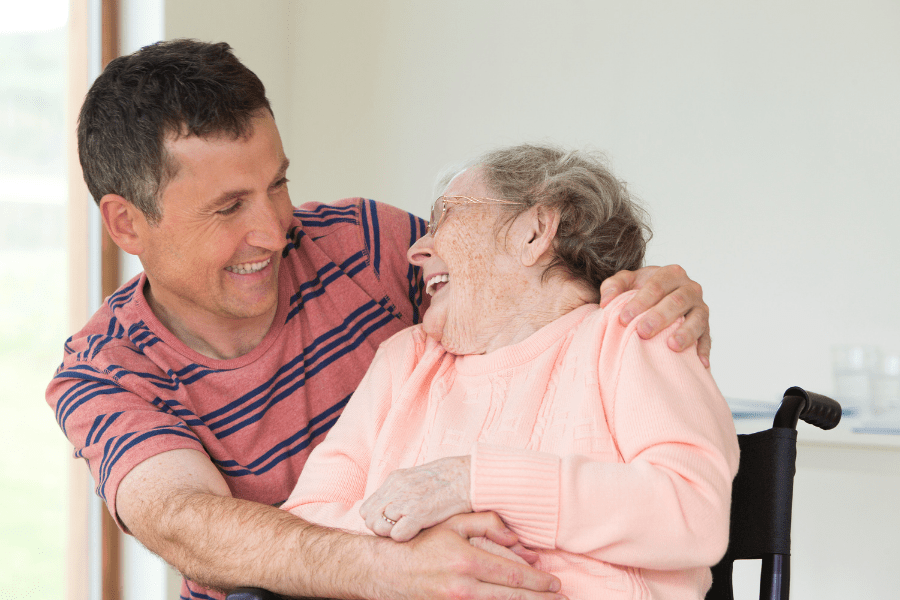
As a caregiver, you know that burnout can significantly affect your well-being outside of work. However, if you care for a patient or loved one who has undergone severe trauma, you could also be at risk for compassion fatigue. Keep reading to learn more.
Updated July 7, 2022
What You Need To Know About Compassion Fatigue
It’s not uncommon for people with high levels of empathy to “feel similar fear, pain, and suffering” when listening to “stories of fear, pain, and suffering of others,” according to this document. It’s important to realize that compassion fatigue can have far-reaching ripple effects. For this reason, informing yourself about this relatively new issue can reduce your risk.
What Is Compassion Fatigue?
In 1995, university professor and researcher Charles R. Figley defined compassion fatigue as a condition that affects “individuals who provide therapy to victims of posttraumatic stress disorder (PTSD).”
Also known as secondary traumatic stress disorder (STSD) or “vicarious traumatization,” compassion fatigue often occurs “as a result of helping or wanting to help a traumatized person.” Overall, those who work closely with individuals with PTSD are particularly vulnerable to compassion fatigue and caregiver burnout. However, learning more about this condition, including recognizing the signs and learning how to cope, can make a big difference.
Compassion Fatigue Symptoms
Compassion fatigue can affect your overall well-being and quality of life. So if you notice any of the following compassion fatigue symptoms, consider talking to a mental health professional or your doctor right away:
- Depression
- Existential despair
- Weakened cognitive skills
- A greater desire for isolation
- Heightened emotional intensity
- Diminished morale and self-worth
- Behavior and judgment disruptions
- Problems with emotional regulation
- Confusion regarding identity, worldview, beliefs, etc.
- Anger and frustration over seemingly meaningless events
- Sleep difficulties due to heightened nervous system response

Compassion Fatigue Vs. Burnout
In many cases, it isn’t uncommon for someone to simultaneously suffer compassion fatigue and burnout. Both conditions share multiple characteristics, such as:
- Depersonalization
- Emotional, mental, and physical fatigue
- A decreased desire for social interaction
- A diminished sense of pride or accomplishment in your work
However, although these conditions seem similar, they are quite different. According to the American Institute of Stress (AIS), compassion fatigue is “The emotional residue or strain of exposure to working with those suffering from the consequences of traumatic events.” In addition, it “can occur due to exposure on one case or can be due to a “cumulative” level of trauma.”
On the other hand, burnout is a “cumulative process marked by emotional exhaustion and withdrawal associated with increased workload and institutional stress.” Notably, the AIS notes that burnout does not arise from trauma.
The most significant difference between compassion fatigue and burnout is that the former arises more quickly. Alternatively, burnout can occur gradually. Moreover, those who suffer from compassion fatigue often recover faster and experience less severe symptoms – but only if identified and treated early on.
Compassion Fatigue Test
The following compassion fatigue test can help you determine your risk and measure the enjoyment and satisfaction you experience from helping other people.
When you take this test, write the number that most accurately reflects how often you experienced these feelings in the past week. You can find the scoring instructions at the end of the test.
- 0=Never
- 1=Rarely
- 2=A Few Times
- 3=Somewhat Often
- 4=Often
- 5=Very Often
Items About You

1. I am happy.
2. I find my life satisfying.
3. I have beliefs that sustain me.
4. I feel estranged from others.
5. I learn new things from those I care for.
6. I feel connected to others.
7. I have gaps in my memory about frightening events.
8. I feel calm.
9. I balance my work and my free time well.
10. I have difficulty falling or staying asleep.
11. I have outbursts of anger or irritability with little provocation.
12. I am the person I always wanted to be.
13. I startle easily.
14. While working with a victim, I thought about violence against the perpetrator.
15. I am a sensitive person.
16. I have flashbacks connected to those I help.
17. I have good peer support when I need to work through a highly stressful experience.
18. I have had first-hand experience with traumatic events in my adult life.
19. I have had first-hand experience with traumatic events in my childhood.
20. I think I need to “work through” a traumatic experience in my life.
21. I need more close friends.
22. I think there is no one to talk to about highly stressful experiences.
23. I have concluded that I work too hard for my own good.
24. Working with those I help brings me great satisfaction.
25. I am frightened of things someone I helped has said or done to me.
26. I experience troubling dreams similar to those I help.
27. I might be “inoculated” by the traumatic stress of those I help.
28. I wish I could avoid working with people I help.
Items About You & Your Environment

29. I am preoccupied with more than one person I help.
30. Some people I help are particularly enjoyable to work with.
31. I have been in danger working with people I help.
32. I feel that some people I help dislike me personally.
33. I like my work as a helper.
34. I feel like I have the tools and resources to do my work as a helper.
35. I have felt weak, tired, and run-down due to my work as a helper.
36. I have felt depressed due to my work as a helper.
37. I have thoughts that I am a “success” as a helper.
38. I am unsuccessful at separating helping from my personal life.
39. I enjoy my coworkers.
40. I depend on my coworkers to help me when I need it.
41. My coworkers can depend on me for help when they need it.
42. I trust my coworkers.
43. I feel little compassion toward most of my coworkers.
44. I am pleased with how I can keep up with helping technology.
45. I am working more for the money/prestige than personal fulfillment.
46. Although I dislike doing the paperwork, I still have time to work with those I help.
47. I find it difficult to separate my personal life from my helper life.
48. I am pleased with how I can keep up with helping techniques and protocols.
49. As a helper, I have to deal with bureaucratic, unimportant tasks in my work.
50. I plan to be a helper for a long time.
Items About Your Mindset
51. I have felt trapped by my work as a helper.
52. I have joyful feelings about how I can help the victims I work with.
53. I think I am a “failure” as a helper.
54. I have a sense of worthlessness/disillusionment/resentment associated with my role as a helper.
55. I think I am not succeeding at achieving my life goals.
56. I have happy thoughts about those I help and how I could help them.
57. I remind myself to be less concerned about the well-being of those I help.
58. I am losing sleep over a person I help’s traumatic experiences.
59. I might have been “infected” by the traumatic stress of those I help.
60. I have suddenly and involuntarily recalled a frightening experience while working with a person I helped.
61. I have a sense of hopelessness associated with working with those I help.
62. I have felt “on edge” about various things, which I attribute to working with certain people I help.
63. I have experienced intrusive thoughts during particularly challenging times.
64. I avoid specific thoughts or feelings that remind me of a frightening experience.
65. I avoid certain activities or situations because they remind me of a frightening experience.
Scoring Instructions
Please note that research is ongoing on this scale, so you should use the following scores as a guide, not confirmatory information. In addition, cut points are theoretically derived and should be used with caution and only for educational purposes.
- Be sure you respond to all items.
- Mark items for scoring:
- Circle the following 23 items: 4,6-8, 12, 13, 15, 16, 18, 20-22, 28, 29, 31-34, 36, 38-40, 44.
- Put a check by the following 16 items: 17, 23-25, 41, 42, 45, 48, 49, 51, 56, 58, 60, 62-65.
- Put an x by the following 26 items: 1-3, 5, 9-11, 14, 19, 26-27, 30, 35, 37, 43, 46-47, 50, 52-55, 57, 59, 61, 66.
- Add the numbers you wrote next to the items for each set and note:
- Your potential for Compassion Satisfaction (x) 118 and above=extremely high potential; 100-117=high potential;82-99=good potential; 64-81=modest potential; below 63=low potential.
- Your risk for Burnout (check): 36 or less=extremely low risk; 37-50=moderate risk; 51-75 high risk; 76-85=extremely high risk.
- Your risk for Compassion Fatigue (circle): 26 or less = extremely low risk, 27-30 = low risk, 31-35=moderate risk; 36-40 = high risk, 41 or more = extremely high risk.
This test is reproduced from the following source:
- Stamm, B.H. (in press). Measuring Compassion Satisfaction as well as Fatigue: Development History of the Compassion Fatigue and Satisfaction Test. In C.R. Figley (Ed.). Treating Compassion Fatigue. New York: Brunner/Mazel. O.B. Hudnall Stamm, Traumatic Stress Research Group, 1995-1999.
Compassion Fatigue Treatment
If you think you might have compassion fatigue, you should seek professional help. In the meantime, here are a few options for compassion fatigue treatment you can try yourself:
- Talk to someone you trust
- Recognize that your pain is normal
- Eat a balanced diet and exercise regularly
- Improve your sleep hygiene habits
- Allow yourself to take time off from work
- Try hobbies and activities outside of your field
Besides that, there are several things that you should NOT do if you have compassion fatigue, which include:
- Blaming other people
- Engaging in impulsive activities such as seeking a new job, car, relationship, etc.
- Frequently complaining with your coworkers
- Self-medication
- Forgoing your interests and needs
- Working more

Compassion Fatigue Prevention
The AIS provides three steps for compassion fatigue prevention. Although these suggestions may not work for everyone, they could offer some relief.
Awareness
First, understand that stress increases the likelihood of compassion fatigue. So ask yourself what kinds of situations cause you more stress.
Secondly, reflect on your day-to-day work to determine if you experience any of the following. You may be at risk for compassion fatigue if you:
- Feel like your ability to function is diminished or inhibited.
- Experience abnormal levels of distress from ordinary stressors or situations.
- Wake up feeling exhausted in the morning.
- Have little motivation to go to work.
- Work harder than ever but feel like it’s not enough.
- Feel more frustrated and irritable than usual.
- Feel excessive compassion for some but less for others.
- Struggle with feelings of boredom or disgust.
- Experience body aches and sickness more than usual.
Balance

Work/life balance is critical for caregivers, so here are a few ways to maintain balance in your daily life:
- Engage in self-care.
- Allow yourself to participate in hobbies and fun activities that give you joy.
- Take breaks from work before you reach your breaking point.
- Practice mindfulness and gratitude.
- Seek medical help and avoid self-medication.
- Give yourself a few minutes each day to be alone in a quiet place.
- If you suffer from grief or loss, allow yourself to recognize these emotions.
- Learn how to differentiate what you can and can’t control.
Connection
Humans are social creatures that require connection and relationships. So don’t allow yourself to suffer in silence. Instead, reach out to a therapist, clergy member, relative, or someone who will listen.
Besides that, avoid spending too much time with negative people. When you’re at risk for compassion fatigue, a support system of positive individuals is essential for your well-being.
Also, you may consider adopting a pet (if your situation allows for one). Studies have found that petting and playing with pets can lower blood pressure and heart rate.
MeetCaregivers Can Help
If you care for a loved one and think you may be at risk for caregiver burnout or compassion fatigue, MeetCaregivers can help. We’ll match your loved one with a qualified caregiver so that you can take a respite break.
Call us at 1 (888) 541-1136 to learn about our process or Find A Caregiver today.
Visit the Blog for more resources and information about caregiving and senior life.
- Compassion Fatigue: Coping with Secondary Traumatic Stress …. https://www.ojp.gov/ncjrs/virtual-library/abstracts/compassion-fatigue-coping-secondary-traumatic-stress-disorder-those
- “Compassion Fatigue.” The American Institute of Stress, 4 Jan. 2017, www.stress.org/military/for-practitionersleaders/compassion-fatigue.
- Handout 6 What is Compassion Fatigue?. http://nwdrugtaskforce.ie/wp-content/uploads/2013/01/Compassion-Fatigue-Handout-6.pdf
